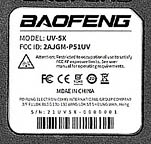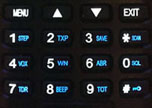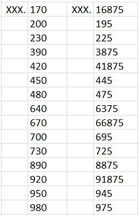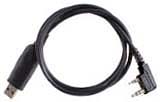Product Review
Baofeng
UV5X / 5G GMRS
(Part 95)

John 'Miklor'
March 2021
|
Opening Facts:
(1) The UV5X and UV5X_GMRS are Not the same radio. (2) There are still a few bugs to be resolved in this radio. (3) Certain functions will Not work until a firmware upgrade is performed. (4) Yes, the firmware is actually upgradable. UV5X_GMRS General Description The UV5X_GMRS is advertised as a 5 watt handheld that is certified and pre-programmed for GMRS operation. (FCC Part 95E). It is not uncommon to see these radios sold in pairs. Do not be confused by the model number. There are two UV5X radios. The one shown above is the UV5X_GMRS specifically for use on GMRS. The other is the UV5X (non-GMRS) shown below. This is a dual band handheld that is neither programmed or certified for GMRS operation.
In the Box * Included with each package of 2 radios is the following: ** - (2) UV5X_GMRS handheld - (2) 7.4V 1800 mAh Li-ion Battery - (2) Charger base & AC adapter - (2) Earpiece / Microphone - (2) Belt clip - (2) Antenna – 6.0" (15cm) - (2) Hand Strap - User Guide * Programming Cable was not included ** Radios normally sold in pairs General Description Frequency Range: GMRS (RX & TX) 136-174 & 400-520MHz (RX) 128 Memory Channels: 30 GMRS (TX/RX) 7 NOAA Weather Channels (RX) 4 Marine Weather Channels (RX) Operation Voltage: DC 7.4 V ±10% Battery Capacity: 1800mAh (Li-Ion) Frequency Stability: ± 2.5ppm Operating Temperature: -20℃ to +50℃ Mode of Operation: Simplex / Repeat Antenna Impedance: 50ohm Certification The UV5X_GMRS received the FCC Part 95E certification 2AJGM-P51UV back in July 2020.
The case measures 4.25 x 2.25 x 1.25" (10.8 x 5.7 x 3.2cm) and weighs in at 6.9oz (196g) with battery and antenna installed. The case is small and light weight. There are no tuning knobs which makes changing channels rely on the up and down arrow keys. The right side of the radio uses a Kenwood K1 style connector for programming and accessories. Antenna The radio comes with a 6.5" antenna that is fixed to the chassis. At the base of the antenna is a tiny hole hiding an extremely small hex screw. This can be loosened for the removal of the antenna. I needed to do this for the power measurements below. To accommodate the locking screw, the radio requires an antenna with an SMA male connector.
The transmit frequency range is limited to the 462-468MHz GMRS range. Over the Air audio reports were good with plenty of audio. Power levels are specified as <5.0W GMRS. Power readings taken with a calibrated Bird Termaline.
Transmit Audio
Audio reports have been very good. I receive the best audio reports when I rest radio on my cheek, holding the radio approximately one inch (2.5cm) away, speaking across the front of the radio. Any further than this and the audio drops off significantly. Frequency Line Up The radio is preprogrammed with 30 hard_coded_transmit frequencies (shown here). 22 Simplex channels, and 8 repeater channels. There are also 11 weather channels programmed; 7 NOAA and 4 marine). The remaining channel slots (receive only) can be programmed via either software or front panel. Receiver & Audio The receiver sensitivity was very good on GMRS as well as VHF and UHF. The audio quality on receive was very good and undistorted with good frequency response. Volume control was smooth with plenty of loud audio coming from the 1w audio amp. The Display The LCD is the traditional tri-color display with selectable colors (Standby, Blue, Orange, Purple).
The LCD supports Alpha characters but these can only be entered using software. Upper Case letters A > Z and numbers 0 > 9 can be shown as well as most special characters. @ # & ( ) - / etc. The software allows you to store and display a max of 6 characters.
Keypad
The back lit keys are small but easy to access with a positive touch, with enough spacing between the keys to prevent pressing two buttons at once. The center
Pre-Programmed Function Keys
CHIRP SoftwareThere are two side keys which are preprogrammed with the following functions: F1 = FM radio / Alarm F2 = Flashlight / Monitor (squelch open) Software / Programming The software is fairly straight forward and easy to use and can be found HERE. It can also be programmed from the front panel, however the options are limited due to the GMRS Part_95_certification. Out of the Box issues The radio would not allow CTCSS tones to be changed via the keypad. The ability to change CTCSS tones using the keypad is handy if you are traveling or have more than one repeater in your area on the same channel. Also, if you have other GMRS transceivers operating with different CTCSS tones assigned, they won't be compatible. Also the power levels are locked and cannot be altered as well as the bandwidth is Locked to Narrowband only. Note: A firmware update is required to correct the above CTCSS issue. HERE. This update will only run on a Windows based computer. Software issue When entering a receive channel in the range of 136.0 to 167.73 MHz, there are 15 frequency combinations that are not accepted when using the software. A channel such as 1xx.700 MHz converts to 1xx.695 MHz. This becomes an issue if you are trying to enter ham channels into the receiver. There is no issue If entered via the keypad, but when downloaded to the software, it will convert back to the incorrect format. Note: This is not related to the software Step settings as the steps are set to 5.0 kHz. It's as though only this frequency step is locked in at 6.25kHz regardless of settings. Examples are shown HERE.
The UV5X_GMRS is now CHIRP compatible. Select the option for Radioddity UV-5G. Do Not use option for the Baofeng UV5X, which is a totally different radio. Firmware Upgradable You read this correctly. The firmware can actually be updated, however you must be using Windows. This is highly recommended as some (not all) of the programming issues I initially found were corrected after updating. The inability to save CTCSS tones via the keypad was one of the issues that was resolved. Programming Cable The programming cable (not included) requires a 2 pin Kenwood K1 style connector. The UART chip is inside the USB plug. As a word of caution, some cables require special drivers while other download the drivers directly from the internet. I personally recommend spending a few extra dollars for a good programming cable and avoid hours of frustration.
Battery and Charger
The battery is an 1800 mAh Li-ion. With moderate use, I can get a full day's use when the battery is fully charged. The charger base uses an included 10V wall wart an takes about 4 to 6 hours to charge a low battery. The LED on the front of the charger is red when charging, and green when fully charged which is pretty standard.
Accessories
The radio comes with an earpiece/microphone. The side jack also accommodates an optional remote Spkr/Micr, and programming cable. Conclusion / Concerns This is a basic GMRS radio. It's compact in size and comes preprogrammed for GMRS operation and NOAA weather receive channels. Transmit and receive performance is good, but requires a firmware upgrade for changing CTCSS tones via the keypad. Most users want to use the radio right out of the box and not deal with doing firmware upgrades. After the update, the CTCSS issue along with the Bandwidth and Power Level issues can be resolved, but the receive channel software issue still remains. (March 2021) Note: This equipment was purchased for the purpose of a fair and unbiased review. All findings are factual based on the equipment I received. Any issues found have been reported both here and back to the seller or manufacturer. Available from: Amazon Baofeng UV5X_GMRS Transceiver Baofeng Programming Cable
|
BTECH 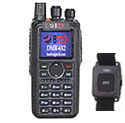 DMR6X2 PRO Dual Band (Review) Anytone 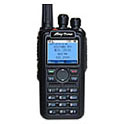 D878UV II+ Dual Band (Review)  D578UV Series Mobiles Hotspot  SkyBridge MAX (Review) Ailunce 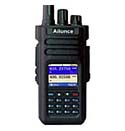 HD1 / GPS (Review) Amplifiers  BTECH DMR Amps UHF VHF (Review) Repeaters  Ham / GMRS Commercial Repeaters Duplexers |

